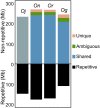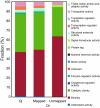Massive gene losses in Asian cultivated rice unveiled by comparative genome analysis
- PMID: 20167122
- PMCID: PMC2831846
- DOI: 10.1186/1471-2164-11-121
Massive gene losses in Asian cultivated rice unveiled by comparative genome analysis
Abstract
Background: Rice is one of the most important food crops in the world. With increasing world demand for food crops, there is an urgent need to develop new cultivars that have enhanced performance with regard to yield, disease resistance, and so on. Wild rice is expected to provide useful genetic resources that could improve the present cultivated species. However, the quantity and quality of these unexplored resources remain unclear. Recent accumulation of the genomic information of both cultivated and wild rice species allows for their comparison at the molecular level. Here, we compared the genome sequence of Oryza sativa ssp. japonica with sets of bacterial artificial chromosome end sequences (BESs) from two wild rice species, O. rufipogon and O. nivara, and an African rice species, O. glaberrima.
Results: We found that about four to five percent of the BESs of the two wild rice species and about seven percent of the African rice could not be mapped to the japonica genome, suggesting that a substantial number of genes have been lost in the japonica rice lineage; however, their close relatives still possess their counterpart genes. We estimated that during evolution, O. sativa has lost at least one thousand genes that are still preserved in the genomes of the other species. In addition, our BLASTX searches against the non-redundant protein sequence database showed that disease resistance-related proteins were significantly overrepresented in the close relative-specific genomic portions. In total, 235 unmapped BESs of the three relatives matched 83 non-redundant proteins that contained a disease resistance protein domain, most of which corresponded to an NBS-LRR domain.
Conclusion: We found that the O. sativa lineage appears to have recently experienced massive gene losses following divergence from its wild ancestor. Our results imply that the domestication process accelerated large-scale genomic deletions in the lineage of Asian cultivated rice and that the close relatives of cultivated rice have the potential to restore the lost traits.
Figures





Similar articles
-
Distinct evolutionary patterns of Oryza glaberrima deciphered by genome sequencing and comparative analysis.Plant J. 2011 Jun;66(5):796-805. doi: 10.1111/j.1365-313X.2011.04539.x. Epub 2011 Mar 21. Plant J. 2011. PMID: 21323774 Free PMC article.
-
A chromosome-level genome assembly of the wild rice Oryza rufipogon facilitates tracing the origins of Asian cultivated rice.Sci China Life Sci. 2021 Feb;64(2):282-293. doi: 10.1007/s11427-020-1738-x. Epub 2020 Jul 28. Sci China Life Sci. 2021. PMID: 32737856
-
Exceptional lability of a genomic complex in rice and its close relatives revealed by interspecific and intraspecific comparison and population analysis.BMC Genomics. 2011 Mar 8;12:142. doi: 10.1186/1471-2164-12-142. BMC Genomics. 2011. PMID: 21385395 Free PMC article.
-
The Genomics of Oryza Species Provides Insights into Rice Domestication and Heterosis.Annu Rev Plant Biol. 2019 Apr 29;70:639-665. doi: 10.1146/annurev-arplant-050718-100320. Annu Rev Plant Biol. 2019. PMID: 31035826 Review.
-
New insights into the history of rice domestication.Trends Genet. 2007 Nov;23(11):578-87. doi: 10.1016/j.tig.2007.08.012. Epub 2007 Oct 25. Trends Genet. 2007. PMID: 17963977 Review.
Cited by
-
Genetics and Genomics of African Rice (Oryza glaberrima Steud) Domestication.Rice (N Y). 2021 Jan 7;14(1):6. doi: 10.1186/s12284-020-00449-6. Rice (N Y). 2021. PMID: 33415579 Free PMC article. Review.
-
Evolutionary Significance of NHX Family and NHX1 in Salinity Stress Adaptation in the Genus Oryza.Int J Mol Sci. 2022 Feb 14;23(4):2092. doi: 10.3390/ijms23042092. Int J Mol Sci. 2022. PMID: 35216206 Free PMC article.
-
Genome-wide association of yield traits in a nested association mapping population of barley reveals new gene diversity for future breeding.J Exp Bot. 2018 Jul 18;69(16):3811-3822. doi: 10.1093/jxb/ery178. J Exp Bot. 2018. PMID: 29767798 Free PMC article.
-
Distinct evolutionary patterns of Oryza glaberrima deciphered by genome sequencing and comparative analysis.Plant J. 2011 Jun;66(5):796-805. doi: 10.1111/j.1365-313X.2011.04539.x. Epub 2011 Mar 21. Plant J. 2011. PMID: 21323774 Free PMC article.
-
Rapid diversification of five Oryza AA genomes associated with rice adaptation.Proc Natl Acad Sci U S A. 2014 Nov 18;111(46):E4954-62. doi: 10.1073/pnas.1418307111. Epub 2014 Nov 3. Proc Natl Acad Sci U S A. 2014. PMID: 25368197 Free PMC article.
References
-
- Khush G. Harnessing science and technology for sustainable rice-based production systems. International Rice Commission Newsletter. 2004;53:17–23.
Publication types
MeSH terms
Substances
LinkOut - more resources
Full Text Sources
Research Materials
Miscellaneous

